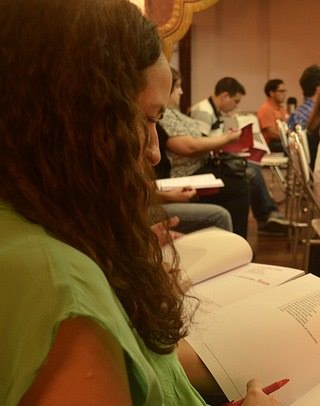Reading Comprehension Strategies
Reading comprehension strategies help students make sense of what they read. You will probably use several of them every time you plan a reading lesson. Consider teaching students some of these strategies for their independent reading as well. (See English Reading Comprehension for one way to do that.)
Pre-Reading Strategies
Create Interest in the Topic

The way you introduce a reading lesson makes a huge difference in both student motivation and comprehension.
Take the time to plan an intriguing introduction to your topic. Arouse student curiosity and help them see the value of learning about it. Raise a few questions the reading selection will answer.
One way to introduce the subject is with an anticipation guide. Write several statements based on the text. (Make some of them false.) Then have students choose which statements they think are true and which are false.
Activate Prior Knowledge
Students need enough background knowledge to grasp the author's main points. This will help them connect what they read with what they already understand.
A quick discussion about the subject before reading can “activate students’ prior knowledge.” (Remind them what they already know about the subject and its vocabulary). It also tells you what students know (and don't know).
You can ask younger students to make a KWL chart, as individuals, pairs, or as a class. (The char records what they already Know, Want to learn, and—after reading—have Learned.) KWL charts can focus their attention on what they hope to get from the reading. They also can let you know if you need to do some pre-teaching.
A short explanation may give students the background they need to understand the reading. If not, do you have access to materials (in class or online) that would enable them to make sense of it? If you can postpone the reading until they get a little background, it might prove far more useful to them.
This education researcher's video explains the need for background knowledge.
Pre-teach Essential Vocabulary
While planning the lesson, look through the reading selection for any important words your students may not know. (Also check for any with new meanings that might confuse them.) If the word is not common, you can get away with a quick explanation or synonym.
If a word is important for understanding the story, can you help students break it apart to familiar roots and affixes? Are there context clues that can help them figure out its meaning?
If it’s a word that they will need often, teach it in more depth. Give examples synonyms and antonyms, etc. (You might also give non-examples—how it isn’t used.) Ask them to use the words you have taught in the post-reading activities.
Scanning and Predicting
When you first pass out the reading selection, ask students to scan it. They should look at the title, introduction or first paragraph, headings, and any illustrations or charts. Have them make predictions about its topic and main ideas. (This will also help them focus on the content as they read, to see if their predictions were correct.)
Reading Comprehension Strategies: While Reading
Remind students to focus on finding the information they need. They should also look for answers to any questions you gave them in the beginning.
Encourage them to keep reading when possible rather than break their concentration by stopping to look up every unknown word. (It will help if you have pre-taught the most important vocabulary. It's also useful for students to know how to decode words and recognize context clues. (They might be worth a special lesson. See Reading Skills.)
You may also want to encourage them to note the main ideas or words they want to look up or discuss later.
Post-Reading Comprehension Strategies
There are many ways to check comprehension. You can have a class discussion or use comprehension questions or a quiz. You can also ask for group or individual summaries or even drawings of the main idea. Be sure to ask some questions that require critical thinking and personal responses to the ideas expressed, not just 5-W factual questions (who, what, where, etc.).
Using several related readings lets students compare the authors’ points of view and possible biases. They should reinforce the content and vocabulary students have learned.
For more reading comprehension strategies, see this Colorin Colorado article. It suggests some excellent comprehension questions.
Reading comprehension strategies and skills are not a magic bullet. As you work with your students you will learn the areas in which they need extra help. Then you can plan lessons targeting their weaknesses and supporting their strengths.
Home>ESL Lesson Plans>Reading Comprehension Strategies.
Didn't find what you
needed? Explain what you want in the search box below.
(For example, cognates, past tense practice, or 'get along with.') Click to see the related pages on EnglishHints.
| site search by freefind | advanced |





